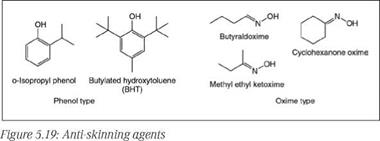Two important classes of anti-skinning agents used in the coating industry are phenols and oximes (Figure 5.19).
Sterically hindered phenol derivatives are commonly used as antiskinning agents because of their powerful antioxidant action, causing considerable loss-of-dry. Typical examples are butylated hydroxytoluene (BHT), and o-isopropyl phenol (Figure 5.19). They act as anti-skinning agents by scavenging free radicals and thereby terminating the polymerization reaction. Due to their considerable anti-oxidant effect, they must be added in low amounts, 0.05 to 0.2 % by mass of the paint, in order to avoid impairing the oxidative drying of the film. Another limitation of additives of this type is that they may cause yellowing of the film.
|
|
Oximes are widely used as anti-skinning agents, but they are mild antioxidants. Their main contribution to antioxidant properties comes through their ability to form labile chelates with metal ions of driers, making them temporarily inactive. Complex formation is reversible, so that in actual drying conditions, the complexes are cleaved and the drier becomes active again. They are volatile and leave the film during the drying process; therefore, their use is not as critical as that of phenols with respect to the loss-of-dry problem. Typical loading levels are 0.05 to 0.3 % of the total mass of the paint. Methyl ethyl ketoxime is probably the most widely used anti-skinning agent, but butyraldoxime and cyclohexanone oxime also find use when low odor is required. Methyl ethyl ketoxime was classified as a carcinogen by the European Union in 2001, and therefore its use is restricted.
 20 января, 2016
20 января, 2016  Pokraskin
Pokraskin 
 Опубликовано в рубрике
Опубликовано в рубрике 